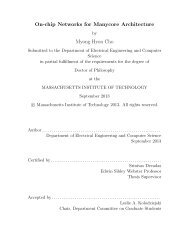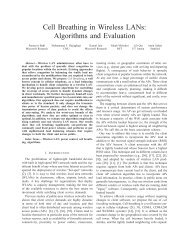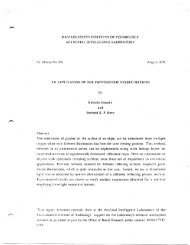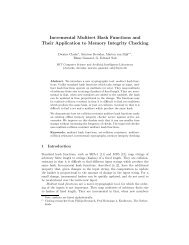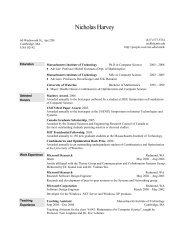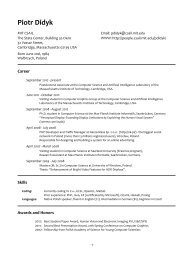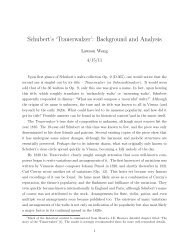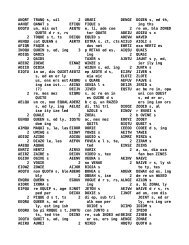Growing Solver-Aided Languages with ROSETTE - People - MIT
Growing Solver-Aided Languages with ROSETTE - People - MIT
Growing Solver-Aided Languages with ROSETTE - People - MIT
You also want an ePaper? Increase the reach of your titles
YUMPU automatically turns print PDFs into web optimized ePapers that Google loves.
1 #lang s-exp websynth<br />
3 (define dom<br />
4 (DOM "[document]" ’()<br />
5 ‘(,(DOM "html" ’()<br />
6 ‘(,(DOM "body" ’()<br />
7 ‘(,(DOM "ul" ’()<br />
8 ‘(,(DOM "li[0]" ’()<br />
9 ‘("Hello"))<br />
10 ,(DOM "li[1]" ’()<br />
11 ‘("World")))))))))))<br />
13 (define-symbolic z0 z1 z2 z3 z4 string?)<br />
14 (define zp (list z0 z1 z2 z3 z4))<br />
15 (evaluate zp (solve (assert (zpath? zp dom "World"))))<br />
(a) Synthesizing a ZPath to scrape the string<br />
“World” from the HTML page shown in (b)<br />
<br />
<br />
<br />
Hello<br />
World<br />
<br />
<br />
<br />
(b) A tiny HTML page<br />
4.1 WebSynth<br />
’("[document]"<br />
"html"<br />
"body"<br />
"ul"<br />
"li[1]")<br />
(c) The output of the program in (a)<br />
Figure 13. A sample WebSynth program<br />
WebSynth is a solver-aided system for example-based web<br />
scraping. The problem of retrieving data from HTML files<br />
is surprisingly difficult in practice—it is usually solved by<br />
writing custom scripts or regular expressions, which must<br />
be manually revised whenever the target page changes. The<br />
problem is compounded when many slightly different scripts<br />
have to be maintained in order to scrape data from related,<br />
but separately coded and maintained web sites (e.g., to collate<br />
meeting schedules for organizations <strong>with</strong> many independent<br />
chapters, such as Alcoholics Anonymous).<br />
WebSynth takes a more robust, solver-aided approach to<br />
the scraping problem. Given an HTML file and one or more<br />
representative examples of data that should be retrieved, the<br />
system synthesizes a single ZPath expression that can be used<br />
to retrieve all of the example data. ZPaths are expressions<br />
in the ZPath language, which is a declarative DSL based<br />
on XPath [42]. Expressions in the language specify how to<br />
traverse the HTML tree to retrieve the desired data, and the<br />
retrieval is performed by the ZPath interpreter. For example,<br />
the ZPath "/html/body/div/" selects all top-level DIV elements<br />
in an HTML tree. ZPath nodes can also include indices that<br />
enable selection of a particular child of a node in the path.<br />
Because ZPaths are generated automatically by the solver,<br />
it is easy to maintain them—if the tree structure of the target<br />
page changes, the synthesizer is re-executed to produce a new<br />
script. In fact, during the development of WebSynth, one of<br />
its benchmark pages [19] was restructured, and the system<br />
was able to generate another scraper for it in seconds.<br />
The WebSynth system was developed by two undergraduate<br />
students in just a few weeks. They first implemented their<br />
ZPath interpreter and a DOM data structure for representing<br />
HTML trees in Racket. Figure 12 shows an excerpt from this<br />
implementation. ZPaths are modeled as lists of string tokens<br />
(such as “html” or “div[0]”), and a DOM node is a struct<br />
<strong>with</strong> fields for storing the node’s HTML tag and children. The<br />
interpreter simply checks that a given list of strings forms<br />
a ZPath between two elements in the HTML tree—for example,<br />
the root of the tree and a string to be scraped. This<br />
initial prototype enabled the students to test the system by<br />
providing concrete ZPaths to the interpreter and checking that<br />
they retrieved the desired data, e.g., the top 100 song names<br />
from Apple’s iTunes Charts [19].<br />
The next step was to turn the ZPath interpreter into a<br />
synthesizer using <strong>ROSETTE</strong>. This involved changing the<br />
implementation language from Racket to <strong>ROSETTE</strong>; making<br />
ZPaths symbolic by letting each element of a ZPath list be a<br />
fresh symbolic value; 5 and asserting that the example data is<br />
retrieved by running the interpreter on the symbolic ZPath.<br />
Figure 13 shows a sample HTML page; the ZPath program<br />
generated for this page and the example input “World”; and<br />
the result of executing the program in <strong>ROSETTE</strong>.<br />
The system handles multiple input examples by extending<br />
the one-input case as follows. For each input example i, we<br />
create a symbolic ZPath zp i that scrapes just i (see lines 13-14<br />
in Figure 13a). Then, we create a symbolic mask—expressed<br />
as a nested list of symbolic booleans—that can be applied<br />
to the individual zp i ’s to compute a generalized ZPath that<br />
scrapes all the given data. For example, to scrape both “Hello”<br />
and “World” from the page in Figure 13, the system replaces<br />
the last three lines of our ZPath program <strong>with</strong> the following<br />
code (as well as the code that creates the zp i ’s and the mask):<br />
(define model<br />
(solve (begin (assert (zpath? zp0 dom "World"))<br />
(assert (zpath? zp1 dom "Hello"))<br />
(assert (generalizes? mask zp0 zp1)))))<br />
(generalize (evaluate mask model)<br />
(evaluate zp0 model) (evaluate zp1 model))<br />
WebSynth can synthesize ZPaths for real websites, <strong>with</strong><br />
DOMs that consist of thousands of nodes, in a few seconds.<br />
Table 1 shows the performance data we obtained by applying<br />
WebSynth to three example web pages: iTunes Top 100<br />
Songs [19]; IMDb Top 250 Movies [18]; and AlAnon AR<br />
Meetings [4]. The second and third column display the size of<br />
each page, given as the number of DOM nodes and the depth<br />
of the DOM tree. We scraped each page four times, varying<br />
the number of input examples. The corresponding rows in<br />
the table show the total running time and just the solving<br />
time for each set of examples. The solving time includes<br />
symbolic execution, compilation to formulas, and the solver’s<br />
running time. All example sets for a given page correspond<br />
to the same generalized ZPath. The IMDb ZPath extracts the<br />
titles of the 250 movies listed on the page; the iTunes ZPath<br />
extracts the title and the artist for each song; and the AlAnon<br />
ZPath extracts the group name, address and city for each<br />
5 <strong>ROSETTE</strong> allows use of symbolic strings that are treated as atomic values—<br />
i.e., they can be compared for equality but are otherwise uninterpreted.



